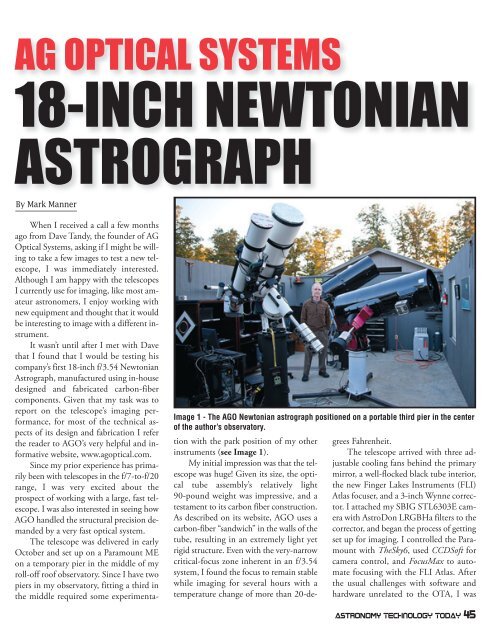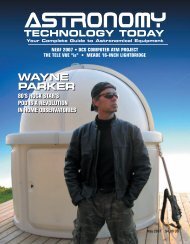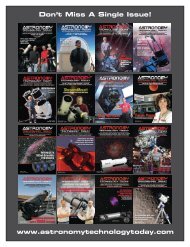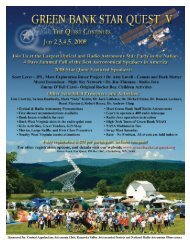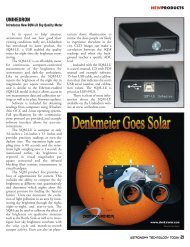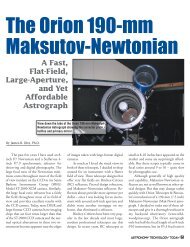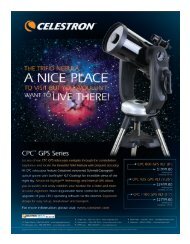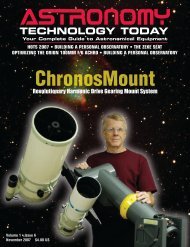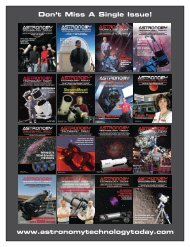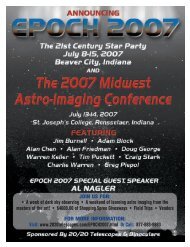magnilux - Astronomy Technology Today
magnilux - Astronomy Technology Today
magnilux - Astronomy Technology Today
You also want an ePaper? Increase the reach of your titles
YUMPU automatically turns print PDFs into web optimized ePapers that Google loves.
AG OPTICAL SYSTEMS<br />
18-INCH NEWTONIAN<br />
ASTROGRAPH<br />
By Mark Manner<br />
Image 1 - The AGO Newtonian astrograph positioned on a portable third pier in the center<br />
of the author’s observatory.<br />
When I received a call a few months<br />
ago from Dave Tandy, the founder of AG<br />
Optical Systems, asking if I might be willing<br />
to take a few images to test a new telescope,<br />
I was immediately interested.<br />
Although I am happy with the telescopes<br />
I currently use for imaging, like most amateur<br />
astronomers, I enjoy working with<br />
new equipment and thought that it would<br />
be interesting to image with a different instrument.<br />
It wasn’t until after I met with Dave<br />
that I found that I would be testing his<br />
company’s first 18-inch f/3.54 Newtonian<br />
Astrograph, manufactured using in-house<br />
designed and fabricated carbon-fiber<br />
components. Given that my task was to<br />
report on the telescope’s imaging performance,<br />
for most of the technical aspects<br />
of its design and fabrication I refer<br />
the reader to AGO’s very helpful and informative<br />
website, www.agoptical.com.<br />
Since my prior experience has primarily<br />
been with telescopes in the f/7-to-f/20<br />
range, I was very excited about the<br />
prospect of working with a large, fast telescope.<br />
I was also interested in seeing how<br />
AGO handled the structural precision demanded<br />
by a very fast optical system.<br />
The telescope was delivered in early<br />
October and set up on a Paramount ME<br />
on a temporary pier in the middle of my<br />
roll-off roof observatory. Since I have two<br />
piers in my observatory, fitting a third in<br />
the middle required some experimentation<br />
with the park position of my other<br />
instruments (see Image 1).<br />
My initial impression was that the telescope<br />
was huge! Given its size, the optical<br />
tube assembly’s relatively light<br />
90-pound weight was impressive, and a<br />
testament to its carbon fiber construction.<br />
As described on its website, AGO uses a<br />
carbon-fiber “sandwich” in the walls of the<br />
tube, resulting in an extremely light yet<br />
rigid structure. Even with the very-narrow<br />
critical-focus zone inherent in an f/3.54<br />
system, I found the focus to remain stable<br />
while imaging for several hours with a<br />
temperature change of more than 20-degrees<br />
Fahrenheit.<br />
The telescope arrived with three adjustable<br />
cooling fans behind the primary<br />
mirror, a well-flocked black tube interior,<br />
the new Finger Lakes Instruments (FLI)<br />
Atlas focuser, and a 3-inch Wynne corrector.<br />
I attached my SBIG STL6303E camera<br />
with AstroDon LRGBHa filters to the<br />
corrector, and began the process of getting<br />
set up for imaging. I controlled the Paramount<br />
with TheSky6, used CCDSoft for<br />
camera control, and FocusMax to automate<br />
focusing with the FLI Atlas. After<br />
the usual challenges with software and<br />
hardware unrelated to the OTA, I was<br />
<strong>Astronomy</strong> TECHNOLOGY TODAY 45


